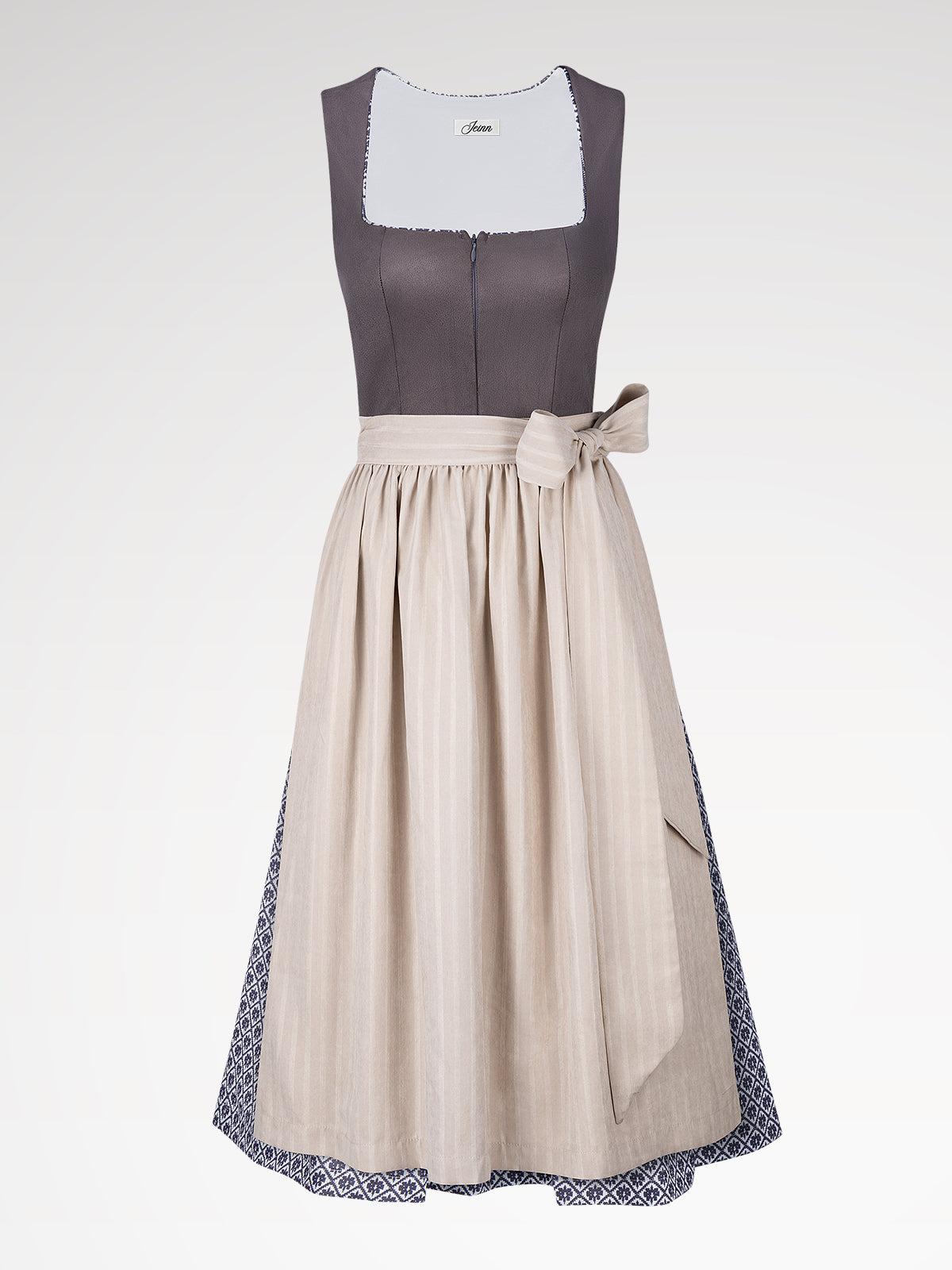The humble beginnings: work clothes of Alpine farmers
In the 19th century, the dirndl served as robust everyday clothing for peasant women and maids in the Alpine regions of Bavaria and Austria. Made of coarse linen or cotton, functionality and freedom of movement were paramount. The cut—a simple pinafore with an apron—enabled hard field work, while dark colors like Dirndl Gray were practically resistant to soiling. The designs varied regionally: each valley developed its own embroidery patterns and color combinations that reflected local identities.
The Aristocratic Appropriation: From the Farm to Salon Fashion
At the end of the 19th century, the nobility discovered the dirndl for themselves. Tourists from cities romanticized rural life, and noble ladies adapted the traditional costume for their country excursions. This is where the transformation began:
- Material revolution: Silk, velvet and fine woolen fabrics replaced coarse linen.
- Silhouette refinement: waists were cut narrower, necklines were emphasized more elegantly.
- Colour refinement: Instead of purely practical dark tones, pastel nuances and elegant dirndl grey found their way into the fashion scene.
This aestheticization culminated in the "Gallery of the Beautiful" (1827–1850), where Munich aristocrats were portrayed in luxurious dirndls – an early evidence of the change in status.
Instrumentalization in National Socialism: The Dirndl as a Propaganda Tool
The 1930s perverted the cultural significance of the dirndl. The Nazi Party exploited it as a symbol of "pure German femininity." Regional diversity was replaced by a standardized "Reichsdirndl":
- Political guidelines: Brown or green fabrics dominated; decorations were militarized (e.g., eagle appliqués).
- Social control: Wearing it became compulsory on official occasions to demonstrate "national community."
This appropriation placed a heavy burden on the garment after 1945 – for decades it was considered ideologically contaminated.
Renaissance after 1945: From traditional symbol to global fashion phenomenon
The 1950s marked the reclaiming of the dirndl by civil society. Traditional costume associations and tourism promoted a depoliticization:
- Oktoberfest boom: As a festive dress for international visitors, the dirndl became a cultural ambassador.
- Design liberalization: Midi lengths (Dirndl Midi) established themselves as a contemporary alternative, combined with modern blouses.
Luxury labels like Lola Paltinger revolutionized aesthetics: hand-painted silk and artistic embroidery catapulted the dirndl into haute couture.
Haute Couture meets tradition: Prada's homage to the Alpine dress
Miuccia Prada's Spring/Summer 2019 collection demonstrated the global design relevance of the dirndl cut. She deconstructed its DNA:
- Silhouette abstraction: The typical bodice waistband was interpreted as a technically shaped corset.
- Material contrasts: Synthetic satin in neon colors or deep dirndl gray replaced cotton.
- Apron Quote: Aprons were reduced to decorative bands, often woven from metal threads.
This avant-garde interpretation proved that the dirndl is not a folkloristic relic, but a timeless formal language.
Contemporary trends: sustainability, individuality and the midi hype
Today, three trends define the market:
- Ecological quality: Organic cotton, recycled materials, and plant-dyed fabrics (e.g., Dirndl Grey made from indigo) are on trend.Labels like FKK Hamburg offer minimalist, urban dirndls without an apron for office use.
- Midi length as the gold standard: The midi dirndl (ankle-length) dominates collections – practical for festival tents, elegant enough for galas. Seasonal Dirndl Midi Sale-Actions make this variant accessible.
- Gray is the new black: Elegant dirndls in gray velvet or silk offer a nuanced alternative to traditional floral patterns. It combines understatement with cultural authenticity—ideal for urban dirndl wearers.
The future: From digital dirndls to circular fashion
Innovations are on the horizon:
- Smart Textiles: Conductive threads integrate LED elements into dirndl midi skirts for evening sparkle effects.
- Zero-waste patterns: Designers like Nathalie Bault create dirndls from a single piece of fabric to minimize waste – a step toward climate-neutral traditional costumes.
- Digital customization: Apps allow virtual fitting of Dirndl Grau models before purchase; AI-generated embroidery patterns personalize each unique piece.
Epilogue: The inexhaustible adaptability of a cultural asset
From field smocks to Prada runway statements – the dirndl has transcended ideologies, fashions, and social upheavals. Its secret to success lies in the dialectical balance between tradition and innovation. Current developments such as sustainable dirndl midi sales or technical dirndl gray designs demonstrate that this silhouette remains a living cultural archive. It preserves stories but constantly transforms them – a garment as a timeless symbol of female identity.





Leave a comment
This site is protected by hCaptcha and the hCaptcha Privacy Policy and Terms of Service apply.